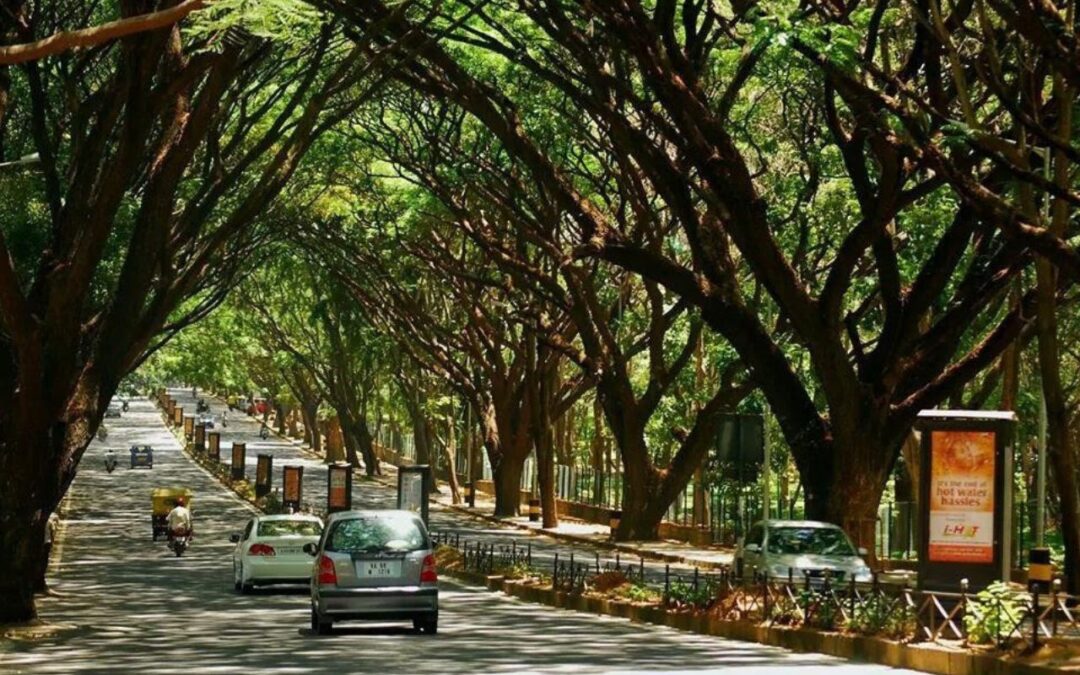Synopsis – The well-designed roadways, green spaces, and local amenities illustrate Jayanagar as the model development of Bangalore for sustainable people-oriented urban development encompassing applicable lessons for successful urban planning.
Jayanagar is one of the oldest and most developed areas in Bangalore, and is unique for its harmonious layout and rich civic infrastructure. Following independence, the City Improvement Trust Board (CITB, now Bengaluru Development Authority (BDA)) developed the area in the 1950’s. Jayanagar’s greenery and road layout remains as an example to urban planners today. This case study will reflect on Jayanagar’s beginnings, innovative planning, and lasting livability that explain its iconic status today.
Historical Background
As per the Kannada language, The word “Jayanagar” when split into two words, Jaya and nagar literally makes it Victory City. One school of thought is that Jaya comes from Mysore’s Maharaja Jayachamarajendra Wadiyar. Jayanagar was planned between 1948 and the late 1950’s, by the CITB, responding to the growing housing demands for the City of Bangalore following independence.
The goal was to create a model township with design principles similar to a garden city, with plenty of green spaces and essential community infrastructure. Jayanagar was officially opened in 1948, and quickly became the largest planned township in south Bangalore, and one of the earliest planned layouts in all of Asia.
Designing the Urban Fabric
Jayanagar behaves like a grid of “Main Roads” and “Cross Roads” that offers mobility for residents and a more intuitive layout of the area. The neighbourhoods are partitions of numbered “Blocks,” and the required RU (Resource Unit), CU (Capacity Unit), and IU (Internal Unit) ratio serves to reduce crowding and congestion. Planners incorporated schools, markets, and parks into the community through a walkable distance and designed wide streets with tree coverage that encourages pedestrian movement and a vibrant sense of community. The tree coverage and public spaces are allocated methodically, with nearly every Block containing parks in addition to the parks within and mixed use structure of “Blocks” in the township.
Infrastructure and Civic Amenities
The original planners put a high priority on durable infrastructure, taking water, power, drainage, and sanitation as a must for the layout. It is extremely accessible with Metro connections (the Green Line and Yellow line at RV Road and South End Circle), BMTC bus stations, and well-maintained internal roads. The shopping complex of Jayanagar, the sports clubs, the libraries, and the schools supply the availability of civic life. There has also been a sufficient amount of space built into the township’s design to allow for setbacks and future road widening, and utility upgrades.
Green Spaces and Environment
Jayanagar is famous for its parks, tree-fringed boulevards, and proximity to the Lalbagh Botanical Garden, all constituting a lung for the locality. Lakshman Rao Park, Madhavan Park and Jayanagar Bridavana park. These parks of Jayanagar are popular for their green spaces, recreational facilities, and cultural landmarks. No new area of Bangalore likely has more parks per capita than Jayanagar, making it one of the greenest and cleanest neighbourhoods in Bangalore. This green coverage keeps air quality high and temperatures low, and enhances livability compared to, for example, areas that are mostly bricks such as Koramangala or HSR Layout.
Land Use and Zoning
Zoning demarcations are strict, with obsolete high-rise constructions prohibited, and differentiations clearly existing between purely residential, commercial, or mixed use zones. Mixed-use zoning around 4th and 5th Block makes it convenient to access the markets and other services without engaging in the over-crowding seen in areas that were never planned.
Social and Cultural Landscape of Jayanagar
- Multi-Generational Residential Community: Jayanagar comprises established family units that have lived there for generations. This means that there is a close-knit community with considerable local depth and traditions.
- Integrated Local Commercial and Cultural Spaces: Within the area are more than a few vibrant local markets, such as the iconic 4th Block Market, which serve as nodes of economic exchange and social connectivity for residents attending to daily living needs. Many temples, schools, theaters, such as Ranga Shankara, as well as cultural associations provide these spaces of community and social connectedness, as well as spaces to uphold history and culture to be present in the community.
- Strong Community Involvement: Most residents actively participate in efforts to help keep the neighborhood clean, safe and historically engaged in their surrounding environment and culture through welfare associations and civic groups. Events, festivals, and volunteerism create community involvement and support the culture of Jayanagar, felt in its welcoming attributes and the collective identity for each group member.
Also read: 8 Fastest Growing Areas in Bangalore That Investors and Homebuyers Are Eyeing in 2025
Real Estate Perspective
Because of its planning pedigree, Jayanagar has property values among the highest in South Bangalore. As of 2025, premium apartments are valued between ₹13,000–₹20,000 per sq.ft., with bungalows valued even higher. Rental rates are strong, especially for family-friendly housing and PGs (paying guests) due to long-term investment possibilities. Comparatively, nearby unplanned neighbourhoods experience larger price variance and slower price appreciation due to lagging infrastructure.
Challenges and Modern-Day Pressures
Rising vehicular traffic and the commercialization of some residential plots, particularly around the 4th Block Market, are a strain on the original master plan. Tension is building between the need for redevelopment and the desire to preserve the low-rise, green environment of Jayanagar. Even amidst pressures, the neighborhoods are still characterized by organized community associations and Administrator regulations designed to maintain the core features that the neighborhoods were originally conceived.
Future Outlook of Jayanagar: Overview of Points
- Consistent Appreciation of Property Values: As per reports, Property values in Jayanagar are expected to appreciate steadily at about 6-8% YoY change, leading to a total appreciation of about 20-30% in total property values over the next five years as a direct benefit of the ongoing advancements in infrastructure, which keep the planned character of Jayanagar.
- Growth in Infrastructure Will Enhance Values: The completion of the Yellow Line connecting RV Road to Bommasandra, alongside numerous upgrades to roads and ongoing tunnels and flyovers at various stages of completion, are further anticipated to raise real estate prices by 15-20% over the next 3-5 year horizon.
- Strong Demand for Quality Residential Real Estate: As property values increase steadily in Jayanagar, demand will remain strong as families and professionals seek quality residential space, which will ultimately support not only rents but also yields and resale values.
- Emerging Green & Smart Initiatives: There will be a thrust on sustainable development in general and more green space, particularly through development efforts positioned as more ecologically and environmentally oriented and advancements in infrastructure towards smart traffic and water conservation initiatives, supporting Jayanagar’s reputation as a model for sustainable urban living.
- Appreciation of Prices through 2030: Property values could appreciate at a rate of approximately 25-30% through 2030, at which time Jayanagar being a great multi-generational investment magnet area, principally in the premium apartment segment and heritage bungalow conversions, is expected to appreciate at an even faster pace.
Written By Rachna Rajput



